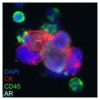Ecological paradigms to understand the dynamics of metastasis
- PMID: 26458994
- PMCID: PMC4826855
- DOI: 10.1016/j.canlet.2015.10.005
Ecological paradigms to understand the dynamics of metastasis
Abstract
The process by which prostate cancer cells non-randomly disseminate to the bone to form lethal metastases remains unknown. Metastasis is the ultimate consequence of the long-range dispersal of a cancer cell from the primary tumor to a distant secondary site. In order to metastasize, the actively emigrating cell must move. Movement ecology describes an individual's migration between habitats without the requirement of conscious decision-making. Specifically, this paradigm describes four interacting components that influence the dynamic process of metastasis: (1) the microenvironmental pressures exerted on the cancer cell, (2) how the individual cell reacts to these external pressures, (3) the phenotypic switch of a cell to gain the physical traits required for movement, and (4) the ability of the cancer cell to navigate to a specific site. A deeper understanding of each of these components will lead to the development of novel therapeutics targeted to interrupt previously unidentified steps of metastasis.
Keywords: Dispersal; Epithelial–mesenchymal-transition; Homing; Metastasis; Microenvironment; Transmogrification.
Copyright © 2015 The Authors. Published by Elsevier Ireland Ltd.. All rights reserved.
Figures





References
-
- Baguette M, Van Dyck H. Landscape connectivity and animal behavior: functional grain as a key determinant for dispersal. Landscape ecology. 2007;22:1117–1129.
Publication types
MeSH terms
Substances
Grants and funding
LinkOut - more resources
Full Text Sources
Other Literature Sources
Medical

